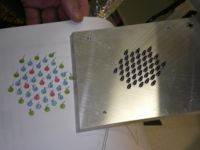Mini-prototype
Drift Chamber prototypes were constructed to evaluate drift chamber designs for CLAS12

Mini-prototype Performance Measurements
General Operating Condition
Chamber Ionization Gas
Our initial plan will be to use (75/25) flowing though the chamber at a flow rate high enough to exchange the volume once a day.
high Voltage supply
A CAEN 4 channel high voltage supply (N470) will be used to supply HV for the drift chambers. The supply is capable of monitoring currents at the microAmp(A) level and voltages at the Volt (V) level.
Signal Processing

The output signals from the drift chamber will be processed through several
NIM based modules.
Dan or Phil: Insert specs of amplifier needed to see DC signals
A descriminator from Lecroy whith a threshold range from 30 mV up to 1.5 Volts will be used to create a stop pulse for TDCs that are started by scintillators which detect either an electron, during tests at the IAC, or cosmic rays, during tests at the LDS (see below). Hall B has loaded the ISU group a TDC module for the drift chamber studies. Pulse height studies may also be done using an ADC. The DAQ system to manage the signal processing electronics is described below.
Cosmic tests
Place chamber between two plastic scintillator paddles to check signals.
scope pulses
DAQ
describe the DAQ for measuring detector output
Electron test facility
IAC 25 MeV electron accelerator
secondary electron beam setup
Description of collimation system goes here as well as lead pencil target. Description of how beam size will be measured or why it isn't needed.